Abstract
The cleaning of textile artefacts and in particular historical tapestries is generally carried out using standard methods. Different cleaning procedures, including a new method based on a hydro-aspiration mechanism, recently developed by restorers with the aim of improving the efficiency of the cleaning system, were applied to a historical tapestry belonging to the lower edge of one of the tapestries of the “Ulysses Stories” series exhibited at the Quirinale Palace (Rome). The tapestry was made of wool and silk and has precious decorations made of metal yarns, which are particularly fragile. The new cleaning system was compared with the traditional methods commonly used by restorers for tapestry cleaning. For this purpose, the quantity and chemical composition of the particles removed and collected on quartz fibre filters by applying the different cleaning systems, were estimated by means of analytical techniques, such as IC (Ion Chromatography) for the quantification of the ionic species collected into the rinsing water, the TOT (Thermal Optical Transmittance) method for the quantification of the carbonaceous particles and SEM-EDX (Scanning Electron Microscopy coupled to Energy Dispersive X-ray Spectroscopy) for yarn morphological characterization and elemental analysis of the deposited particles. The objective of this study is to identify the correct cleaning method to apply to the polymaterial tapestry and, in particular, to the gilded silver and gold metallic yarns, whose conservation state requires the preservation of the “self-protection” patina necessary for the future exhibition inside the Quirinale Palace. The new hydro-aspiration method was found to be more efficient in removing dirt and preserving the structure of the metallic threads being in this way less invasive in detaching the fragile surface patina and at the same time more effective in removing dirt.
1. Introduction
Cleaning is a subject of great interest for all types of artworks. Whereas numerous studies have already been carried out in the field of movable paintings and wall paintings and the materials used in these field have been extensively studied both in the vast scientific literature and in dedicated texts [1], in the field of textiles the interactions that can occur during treatments are not yet completely clear, due to the vast number of cases and problems opened by the presence of polymaterial yarns [2]. The cleaning operation is carried out to remove those substances that are foreign to the original material which, in contact with the weave, can give rise to various degradation factors depending on how the substances and the textile interact.
The removal of particle deposits is the primary condition for the subsequent consolidation of the textile structure, as it brings improvements in terms of softness and flexibility of the yarns, which, freed from the particles, guarantee the combination of the new restoration material into the original [3].
Cleaning, therefore, represents one of the most critical phases of the restoration process. On the one hand, it is the one that has the greatest impact on the visiting public. On the other hand, it is an irreversible operation, since the removal of dirt, whether in the form of particle deposits or a product of decay (oxidation and corrosion of metal threads) always and inevitably entails the loss of original material, compromised due to the natural ageing and physical–chemical alteration of the threads. The tapestry object of the present study (Figure 1 and Figure 2) comes from an important collection of historical tapestries exhibited in the Quirinale Palace in Rome (Italy). It is made of yarns of organic (protein) and ‘partially’ inorganic origin such as metallic yarns consisting of a protein fibre core (silk) and a gold-silver metallic lamina (Figure 3a), each with its own compositional, morphological and conservative properties.
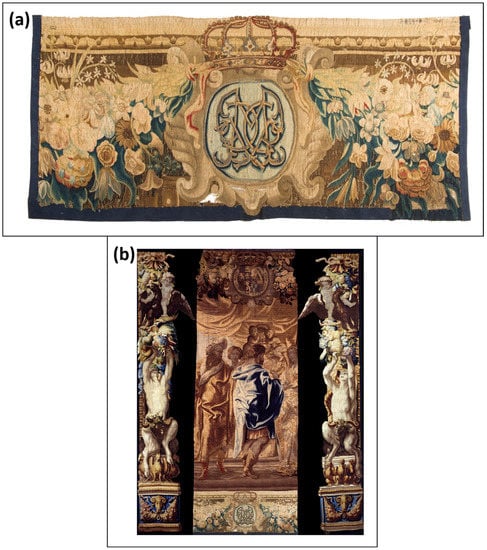
Figure 1.
(a) part of the lower edge of the tapestry “Ulysses Farewells Alcinus: the libation” belonging to the “Ulysses Stories”, Brussels, 1665–1666, 72 cm × 172 cm, Rome, Quirinal Palace; (b) graphic reconstruction of the whole tapestry to which the fragment that was analysed belongs (lower edge).
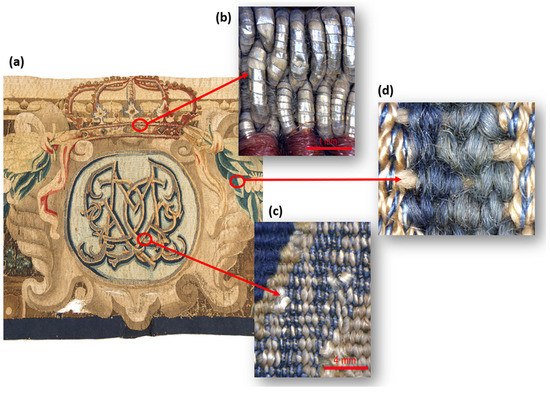
Figure 2.
(a) an enlargement of the tapestry coat of arms; (b) gold metallic yarns; (c) gilded silver metallic yarns; (d) wool and silk yarns.
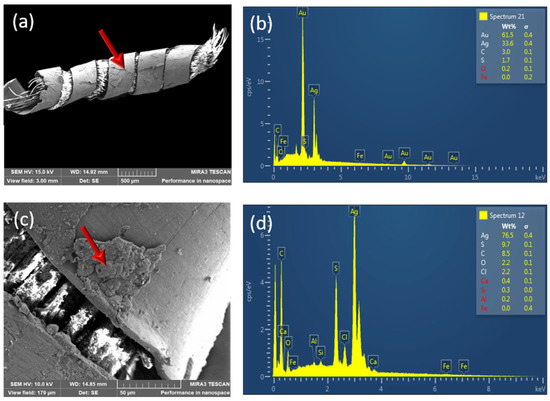
Figure 3.
(a) SEM micrograph (SE) of a metallic yarn: the fibre core around which the metal yarn is wrapped is visible; (b) EDX spectrum (acquired on the point indicated with the arrow in (a)) showing the chemical composition of the gold metallic yarns; (c) SEM micrograph where a self-protection patina is visible; (d) chemical composition of the patina showing the presence of Ag2S and AgCl (spectrum acquired on the point indicated with the arrow in (c)).
The behaviour of the yarns depends on their chemical structure and physical properties including mechanical resistance. Wool and silk, both textile fibres of animal origin with a protein constitution, are highly hygroscopic: they absorb up to 30% humidity without appearing wet; however, wool can undergo the phenomenon of felting due to the combined effect of mechanical rubbing, heat and humidity. As far as reactivity to chemical agents is concerned, wool has an amphoteric behaviour, i.e., it is attacked by both acids and hot concentrated bases; silk, on the other hand, is more tolerant to alkaline attack.
As for metallic yarns, aggressive procedures that aim to expose the metal surface should be avoided, thus preserving the ‘self-protection’ layer (or patina) that, although foreign to the original material, contains traces of it.
Another problem related to cleaning is the stability of the colours, regarding water, solvents additives and heat. Referring to some data in the literature, particulate matter generally present on textile fibres may derive from [4,5]: airborne dust, water-borne substances from the soil (clay, mud), mineral elements (salts, corrosion products), fats and oils, products from candle combustion, soot and combustion fumes, products of organic decomposition, adhesives and substances of unknown nature [2]. The different types of soiling are closely linked to each other, in the sense that a deposit material (e.g., general dust), under certain environmental and exposure conditions (e.g., high RH values, poorly ventilated rooms), can favour the development of organisms and thus the microbiological attack of textile fibres. Depending on the way in which the particulate interacts with the textile polymer weave, different degradation phenomena, such as physical and chemical, can take place. The methods traditionally used for cleaning polymateric textile artefacts are based on physical and/or chemical–physical action, the latter carried out using aqueous solutions. Water is the most commonly used solvent for cleaning. At the same time, this solvent has limitations, proving ineffective towards certain insoluble materials such as hydrophobic substances and the corrosion products of metallic yarns. Hence, the need to add to the solution substances having the ability to dissolve the dirt to be removed and/or trigger chemical reactions to improve the cleaning efficiency.
As mentioned above, the tapestry that is the subject of this study is stored at the Quirinale Palace in Rome, which is the residence of the President of the Italian Republic. The tapestry collection of the presidential endowment consists of 261 items documenting the activities of the main manufactures and production centres between the 16th and 19th centuries. This collection is one of the most remarkable internationally, not only from the numerical point of view. Its importance also lies in the high value that distinguishes its individual work of arts, due to their having previously belonged to the collections of the pre-unitary states. In fact, most of the tapestries arrived at the Quirinale in the 1880s, when the desire to transform the palace into a sumptuous royal palace led to the use of furnishings and works of art taken from the palaces of the ruling houses in Italy before the unification under the Savoy crown. From the collections of the House of Savoy, especially from the royal palace in Turin, many tapestries were taken that were traditionally and perhaps also affectively linked to the House of Savoy. Some of these series were made for the patronage of Charles Emmanuel II, in particular the four tapestries, all made in Brussels, with the Triumph of the Eucharist and Virtues (made in Brussels, 1665); the five Stories of Mark Antony and Cleopatra (1665); the seven Virtues (1665); the six Ulysses Stories (1665–1666), to which the tapestry of this study belongs; and the seven Stories of Charlemagne (1665–1666).
Since 1995, the recovery of a substantial nucleus of the tapestries has been planned and coordinated through two fully equipped laboratories and specialised in-house staff in collaboration with the Ministry of Culture.
Conservation of historic tapestries is undertaken both in public and private workshops in Italy. The tapestry restoration and conservation workshop of the Palazzo Vecchio, which forms part of the Opificio delle Pietre Dure (the Restoration and Conservation Laboratories) is based in Florence. The Palazzo Vecchio is the only public workshop in Italy, and it has a long tradition of treating a wide range of tapestries, as well as playing a prominent role in training Italian tapestry conservators. The Italian presidential residence, the Quirinale Palace in Rome, houses its own workshop that cares for its important collections of tapestries. The Vatican Museum’s workshop, the Laboratory for the Restoration of Tapestries and Textiles is in charge of huge Vatican tapestry collections. The workshop has a long and important tradition of tapestry restoration going back to the eighteenth century. These three workshops are of priority importance in the field of tapestry conservation and restoration in Italy. In addition, they actively undertake research in this sector, with each workshop developing a specific approach and methodology [6]. A further restoration laboratory is represented by the Textile Restoration Laboratory of the Botticino School of Restoration, which was in charge of the restoration of the historical tapestry studied in this work. It is worth noting that 15–17th century Flemish tapestries are among the most precious testimonies of European cultural heritage. Even if in some cases they are in deteriorated condition, these works of art are highly valued and exhibited in many museums all over the world. The present state of degradation evidenced by visual assessment in conservation practice and confirmed with macro-scaled tensile strength tests, reveals the vulnerability of wool and silk fibres to both light exposure and atmospheric pollution. In fact, textiles deteriorate due to natural causes such as heat, radiation, mechanical stress, moisture, microbiological and enzymatic attack and, last but not least, the deposition of dirt, i.e., atmospheric particulate matter including soil dust and carbonaceous particles.
Different cleaning procedures were applied in the present research to a historical tapestry belonging to the lower edge of one of the tapestries belonging to the “Ulysses Stories” series. These procedures included traditional cleaning methods and a new tool based on a hydro-aspiration system. The tapestry object of the study is made of wool and silk and has precious decorations made of metal fibres, which are particularly fragile. The effectiveness of the different cleaning methods was tested and validated through the use of some analytical techniques, such as IC (Ion Chromatography) for the quantification of the ionic species collected into the rinsing water, the TOT (Thermal Optical Transmittance) method for the quantification of the carbonaceous particles and SEM-EDX (Scanning Electron Microscopy coupled to Energy Dispersive X-ray Spectroscopy) for yarn morphological analysis and elemental analysis of the deposited particles. These techniques are commonly used for the characterization of aerosol particulate matter.
2. Materials and Methods
2.1. The Tapestry
The tapestry submitted to restoration is a part of the lower edge of one of the tapestries of the “Ulysses Stories” series, exhibited at Quirinale Palace (Rome) (Figure 1a and Figure 2). In particular, it is a part of the tapestry entitled “Ulysses Farewells Alcinus: the libation” (Figure 1b) and was realized, together with the other pieces belonging to the same series, in Brussels, at the workshops of Jan van Leefdael (Brussels, from 1644 to 1680) or Geraert van der Strecken (Brussels, from 1647 to 1677), on cartoons by Jacob Jordaens (1635) [7]. The lower edge is a polymateric tapestry with wool warps and wool, silk and metallic wefts, forming the work structure and the design. In the centre of it stands a crown and two flower festoons, on a brown background, which encloses a blue circular plate on which is inscribed, in golden letters, the monogram with the initials of Charles Emmanuel II of Savoy and his wife, Maria Giovanna Battista of Savoy-Nemours. The crown motif and monogram are embellished with gilded silver and gold metallic yarns. The tapestry was recently restored at the Textile Restoration Laboratory of the Scuola di Restauro di Botticino [7,8,9].
2.2. The Cleaning Procedures
The cleaning methods applied in this study were: (1) an innovative hydro-aspiration system (method A), (2) immersion washing (method B), (3) low-pressure table (method C) and (4) air aspiration (method D) [7,8,9]. In fact a new method based on a hydro-aspiration mechanism has been developed in the laboratories of the Scuola di Restauro di Botticino [8,9]. The hydro-aspiration system allows a simultaneous physical–chemical action and has been applied on the metal yarns to localize the cleaning and the control of the intervention. The instrument used to realize the cleaning operations was a medical vacuum cleaner, equipped with a Teflon (PTFE) tube on which a polypropylene filter holder was mounted. The four methods have been applied to selected areas of the tapestry having dimensions of 3 × 3 cm2. The cleaning tests were realized by preparing an aqueous solution (deionized water) containing a non-ionic surfactant (saponina RE-puro, Carlo Erba) at 0.02%. Each cleaning method involved three tests, performed in the same spot and under stable conditions (pH ≃ 6, T ≃ 18 °C). The first sampling was performed 1.5 min after the start of cleaning, the second after a further 1.5 min (corresponding to a total of 3 min) and the third after further 2 min (for a total of 5 min). Subsequently, a rinse with deionised water was carried out at the same point. Between each test, the filters were changed, the water was collected and the sampling instrument tubes and filter holder were rinsed with deionised water in order to avoid contamination between tests. The aqueous solutions were stored and analysed by ion chromatography IC (Ion Chromatography) in order to determine the main ion species. During the tests, the deposited particulate matter (DMP) was collected on quartz fibre filters (Whatman™ Quartz Air Sampling Filter, Grade QM-A, Whatman) positioned inside the tube located after the aspiration system used for cleaning. The filters were then analysed by SEM-EDX (Scanning Electron Microscopy coupled with X-ray Energy Dispersive Spectroscopy) and TOT (Thermal-Optical Transmittance) analysis.
2.3. The Analytical Techniques
The main ions’ quantification was performed on the aqueous solution obtained after the cleaning operations by IC analysis using an ICS-1000 HPLC system equipped with a conductivity detector [10,11]. In order to quantify the carbonaceous substances present on the quartz fibre filters, the determination of OC (organic carbon) and EC (elemental carbon) and TC (total carbon) was carried out using a TOT Sunset instrument following the methodology conventionally used for their determination in the aerosol particulate matter [10,11]. Portions with an area of 1.5 cm2 were taken from each filter and then submitted to the analysis.
Selected areas (200 × 200 μm) present on the filters were analysed by SEM-EDX to obtain qualitative/semiquantitative information on the chemical composition. For this purpose, a punch with an area of 1 cm2 was taken from the filter and placed on the sample holder in the chamber of the electron microscope. When necessary, as indicated in the text, analyses were acquired on specific points. The instrument employed was a Hitachi TM1000 equipped with a SwiftED EDX spectrometer from Oxford Instruments Ltd. Measurements were directly performed on samples since no metal coating was required. Furthermore, a SEM-EDS TESCAN MIRA 3 instrument was employed to study the metallic yarn morphology and the chemical composition of the surface patinas.
The quartz fibre filters employed in the hydro-aspiration and traditional methods were weighed before and after the cleaning procedure to quantify the deposited particulate matter (DPM).
3. Results
Notwithstanding the importance of the issue of restoration of the tapestry by cleaning, there are few works in the scientific literature dealing with this aspect [2,4,9] or aimed at a preventive study for tapestries. For example, an interesting study is focused on the acquisition of information about protein breakdown at an early stage, long before fibre deterioration becomes visible [12]. It is worth noting that deterioration of materials causes breakdown of the molecular structure and results in a loss of strength, extensibility and durability, discoloration and fading, which affects the appearance of the textiles.
The polymateric textile object of the present research was made by weaving yarns of different kinds, i.e., wool and silk yarns dyed by different colorants (whose nature has been investigated in other studies [13,14]), gold metallic yarns and gilded silver metallic yarns (Figure 2). It is worth noting that the royal monogram was partially deteriorated showing abrasion of the thin gold layer and presence of corrosion products. The metallic yarns’ degradation has caused the alteration of the original chromatic effect and what was once supposed to appear golden yellow, is now greyed and opaque. Elemental analysis such as SEM-EDX can provide useful information on both the state of preservation of the fibres and the chemical nature of the metal mordant used [15]. By means of SEM-EDX analyses both the composition of the metallic yarns and the chemical nature of the degradation products were investigated. In particular silver corrosion products such as silver sulphide (Ag₂S), silver oxide (Ag₂O) and silver chloride (AgCl) have been highlighted. These species form because of interaction with atmospheric pollutants such as aerosol particulate matter and SO2 [16]. In Figure 3a, a SEM image of a yarn formed by the fibre core around which the metal yarn is wound is provided. The metallic yarns, forming the coat of arms placed in the centre of the tapestry, are gold or gilded silver. The typical composition of a gilded silver yarn is shown in Figure 3b, whereas in Figure 3c an enlargement of the yarn is provided where the self-protection patina is visible, whose composition is shown in the EDX spectrum of Figure 3d.
The problem of tapestry cleaning in the scientific literature, as already mentioned, has rarely been addressed, and to the authors’ knowledge, there are only a couple of works from around 10 years ago [17,18,19] dealing with cleaning procedures.
An important issue as regards the conservation of textile artefacts in museum environments [20] is represented by dust deposition on the work of art’s surface, i.e., the deposition of the so called deposited particulate matter (DPM), which together with the absorption of gaseous pollutants such as SO2 (which is one if the main pollutants affecting air quality [21]) can react with the material giving rise to the formation of secondary species (as stated before). In the literature the effects of DPM on textile artefacts has been investigated in some French museums [19].
In order to evaluate the efficiency of the four different cleaning procedures considered in removing DPM from the tapestry surface, dirt was sampled through time tests (see Section 2.2). The cleaning methods applied are (further details on the specific features of each method are provided in [8,9]):
- –
- Method A: innovative ‘hydro-aspirating’ system;
- –
- Method B: immersion washing;
- –
- Method C: low-pressure table;
- –
- Method D: air aspiration.
In Figure 4, as an example of the cleaning operations, the hydro-aspiration and air aspiration methods, are shown. The cleaning procedure was conducted on selected areas having dimensions of 3 × 3 cm2 on both the tapestry and some mock-up samples suitably realised. These mock-up samples were realized by putting mixtures of compounds on quartz fibre filters in order to simulate an artificial particulate matter. For this purpose, aluminium hydroxide, calcium carbonate, magnesium sulphate heptahydrate and sodium sulphate were employed. Artificial soiling was carried out under forced conditions, using hard bristle brushes with flat tips, so that the mixture adhered to the surface and between the interstices of the weave [9]. The amount of mixture deposited was about 1 g for each mock-up sample and was determined by weighing the sample before and after application of the mixture with the brush. Cleaning tests were also performed on mock-up samples (Figure 4) in order to quantify the deposited particulate material (DPM). It is interesting to note that among the various methods used, the one capable of removing the greatest amount of DPM was immersion washing (Figure 5), although it should be noted that this technique is the most invasive. The method based on hydro-aspiration is the second most more effective one. To confirm the correctness of the observations made on the efficiency of the methods, it can be noted that the trend of the quantity of DPM removed is the same on the tapestry and mock-up samples, as reported in Figure 5.
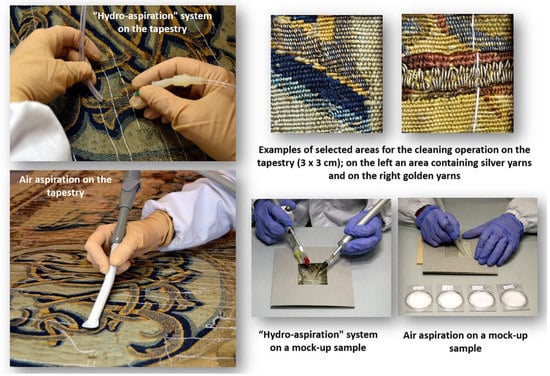
Figure 4.
An example of the cleaning operations: hydro-aspiration and air aspiration methods. On the right side some examples of selected areas submitted to cleaning are shown together with the same two methods applied on some mock-up samples.
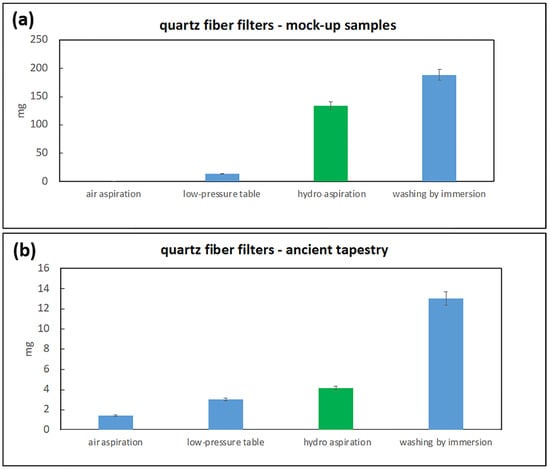
Figure 5.
DPM quantity (mg) collected on quartz fibre filters by means of the different cleaning procedures on selected areas (3 × 3 cm2) of mock-up samples (a) and on selected areas from the ancient tapestry (b).
The morphological characterisation of the surfaces of the quartz filters was performed by means of SEM-EDX analysis. For each sample, a 1 cm2 punch, which visually showed a higher dirt accumulation, was obtained, placed on the sample holder and analysed. For each cleaning method used, the filters collected after 1.5 min and 5 min samplings were analysed. In Figure 6a,b the SEM images of filters collected after 1.5 min and after 5 min together with the corresponding EDX analyses, as regards method A (hydro-aspiration), are shown. The presence of silver and sulphur allows us to assume that the particles are composed of silver sulphide attributable to the degradation of the wire. This finding puts in evidence that the cleaning method applied tends to remove the sulphide flakes that, more or less compactly, cover the metal surface. However, it is interesting to note that when analysing the filter collected after 5 min (Figure 6b), the amount of silver is lower (Table 1): 9.3% compared with 17.3% found on the filter collected after 1.5 min. This means that we can assume that no further silver-containing particles are removed after the first cleaning step. It is worth noting that Si is mainly due to the quartz filter, even if a contribution due to the soil dust deposited on the tapestry surface cannot be excluded, also because of the presence of Al and Ca, elements typical of aluminium calcium silicates. They are among the constituents of the aerosol particulate matter that can be deposited on the works of art.
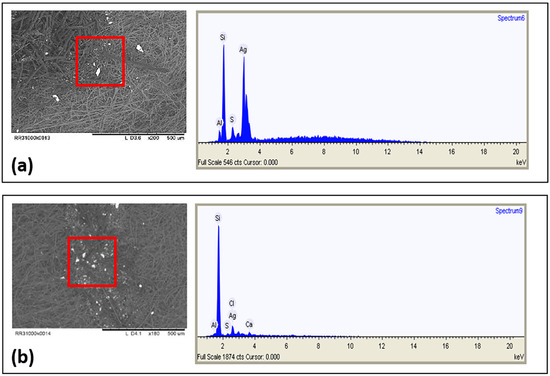
Figure 6.
SEM images and the corresponding EDX analyses acquired on quartz fibre filters by method A (hydro-aspiration) after 1.5 min (a) and 5 min (b).

Table 1.
EDX analysis acquired on area a (a) and area b (b). * Si is mainly due to the quartz filter. The precision of the results reported is 5%.
It is worth noting the comparison of method A with the other cleaning procedures. For example, analyses carried out on the filter collected by method C (lower pressure-table) after 1.5 and 5 min also revealed numerous particles containing sulphur and silver, as shown in Figure 7a,b. Method C appears to be rather invasive as evidenced by the larger size of the silver sulphide particles removed.
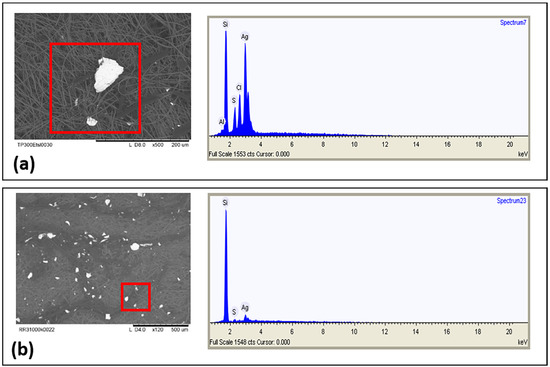
Figure 7.
SEM images and the corresponding EDX analyses acquired on quartz fibre filters by method C (lower pressure-table) after 1.5 min (a) and 5 min (b).
Table 2 shows the results of EDX analyses performed on areas of 200 × 200 μm2 on quartz fibre filters sampled with the four different cleaning methods at different times (for methods C and D, the results obtained after both 1.5 min and 5 min of aspiration are shown). Methods C and D are those that remove the highest amount of Ag (and similarly sulphur, i.e., these methods remove the most protective patina). It should be noted how method D also removes Au particles. It is important to stress that the method based on hydro-aspiration is therefore the least invasive on the metal threads.

Table 2.
EDX analysis acquired on punched areas (200 × 200 μm) of quartz fibre filter collected by the different cleaning methods after 1.5 or 5 min. The precision of the results reported is 5%.
Ion chromatography has been applied to determine ion concentrations in the solutions produced during cleaning operations carried out at certain interval times as described previously in the text.
Comparing the capability of removing soluble species such as chloride, nitrite, nitrate and sulphate, on the base of the results obtained by IC, it has been observed that, in general, the hydro-aspiration method allows removal of a higher quantity of ions. In Figure 8, the trend of ion concentrations in the solutions obtained cleaning by method A on two tapestry areas with gilded silver and gold threads is provided. Gold threads seem to be characterized by higher concentrations of soluble species retained in the solution during the cleaning.
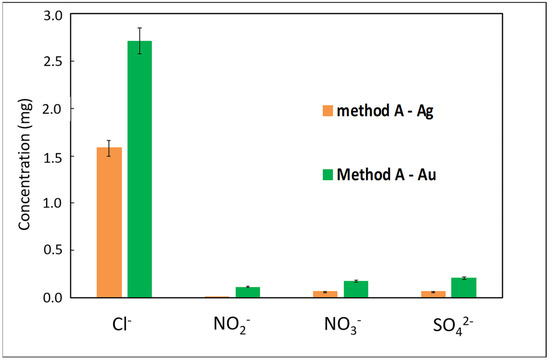
Figure 8.
Trend of ion concentrations determined in the solutions obtained by cleaning two areas where gilded silver or gold threads are present, respectively, using method A.
Finally, in order to determine the amount of carbonaceous material removed by the different cleaning methods, the quartz fibre filters collected by performing the cleaning operations on both a gold and a gilded silver yarn area were analysed using TOT. This technique is normally applied to quantify organic carbon (OC) and elemental carbon (EC) within atmospheric aerosols. In Figure 9, OC, EC and TC (total carbon is the sum of OC and EC) are provided. It is worth noting that elemental carbon, also known as black carbon due to its characteristic dark colour, is the main one responsible for the blackening of the surface. Analyses were performed on filters collected after 1.5, 3, and 5 min and after a 1.5 min rinse. As can be observed, method A based on the hydro-aspiration method (Figure 9a,b) is able to remove more of both OC and EC and is the better choice compared with the other methods. However, by comparing the trends of OC and EC concentrations on the two areas, it can be observed that the gilded silver yarn releases a greater quantity of carbonaceous particles, and a further rinse is also necessary for a complete removal.
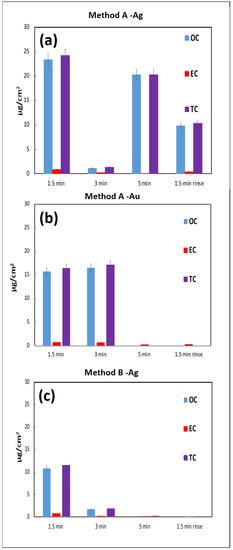
Figure 9.
Trends in the concentrations of carbonaceous species (TC, total carbon; OC, organic carbon; EC, elemental carbon) determined on quartz fibre filters sampled during: (a) the cleaning procedure with method A on an area where a gold thread is present; (b) the cleaning procedure with method A on an area where a gilded silver thread is present; and (c) the cleaning procedure with method B on an area where a gilded silver thread is present.
It is worth noting that TOT measurements are performed on a selected filter area of 1.5 cm2. Because of this, and since the deposition of particles on the quartz filter is not perfectly homogeneous, it was decided not to report the data as total quantity of OC, EC and TC on the filter, and consequently the values are reported as μg/cm2.
4. Discussion
It is important to note that electron microscopy observations revealed the state of degradation of the metal fibres, subject to decohesion, in the central decoration of the tapestry. In addition, SEM-EDX investigations revealed the presence of a patina consisting of silver sulphide. Characterisation of the dirt removed from the surface of both the tapestry studied and some mock-up samples was carried out for the first time using a multi-analytical approach involving techniques such as SEM-EDX, IC and TOT, normally used for the study of atmospheric aerosols. Some important findings emerged:
- –
- The recently developed method based on hydro-aspiration is the one that allows the greatest amount of DPM to be removed from both the tapestry and the mock-up samples (see Figure 5), with the only exception of the washing by immersion method (which is, however, more invasive).
- –
- The hydro-aspiration method is the least invasive in removing the silver sulphide patina present on the surface of the yarns (see Table 2).
- –
- The method based on hydro-aspiration allows the removal of both a greater quantity of ions (chlorides, which are present in higher concentration, nitrates and sulphates) and a higher quantity of carbonaceous particles (both OC and EC), as shown in Figure 9.
Regarding the trend in the removal of carbonaceous particles, the different behaviour of the gold fibres compared with the gilded silver ones (Figure 9), for the same cleaning method (in this case method A), probably depends on the fact that the gilded silver yarns, being coated by the silver sulphide patina, retain more dirt and in particular carbonaceous particles. On the other hand, it was also observed that (Figure 8) a slightly higher quantity of soluble species is removed from gold yarns, even if the trends on the two kinds of yarns are comparable.
Based on the results of the diagnostic investigations, the state of preservation of the original materials and the need to consolidate the textile weave through integrative and conservative restoration was evidenced.
5. Conclusions
The present work is aimed at comparing the efficiency of different cleaning methods, some traditional methods and a recently developed cleaning system, that are applied in the restoration and maintenance of tapestries, a topic that to our knowledge has been little treated in the scientific literature. The analytical set-up developed was applied to a precious tapestry from the Quirinale Palace (Rome). Because of the fragility, in particular the areas where metallic yarns are present on the textile artefact and the need to clean these at the same time preserving the integrity of the metallic yarns, the new recently developed innovative system based on the hydro-aspiration was employed together with more traditional methods.
The analytical techniques applied (SEM-EDX, IC, TOT) allowed us to compare the effectiveness of the different cleaning methods and evaluate their effect on the textile artefact. Although SEM-EDX has been previously employed in some studies to evaluate the state of preservation of textile fibres, IC and TOT, together with SEM-EDX, were applied here for the first time to test and compare the effectiveness of cleaning methods by analysing the deposited dirt, i.e., the carbonaceous fraction present in the particulate matter or the soluble species present on the surface of the tapestry.
The hydro-aspiration method turned out to be the least invasive one towards the metal yarns, allowing removal of dirt but at the same time preserving the yarns and avoiding detaching the fragile corrosion patinas. In conclusion, the added value of the present work with respect to the state-of-the-art in the field is to have a less invasive and at the same time effective cleaning method available.
Author Contributions
Conceptualization, P.F. and E.M.; methodology, P.F., E.M., R.B. and E.B.; formal analysis, V.C., L.S. and E.M.; investigation, V.C., L.S. and E.M.; data curation, V.C., L.S., A.B. and C.A.L.; writing—original draft preparation, P.F. and V.G.; writing—review and editing, P.F., V.C., C.A.L., A.B. and M.B.; supervision, P.F.; project administration, P.F., R.B. and E.B.; funding acquisition, P.F., R.B. and E.B. All authors have read and agreed to the published version of the manuscript.
Funding
This research received no external funding.
Informed Consent Statement
Not applicable.
Data Availability Statement
Data will be made available upon request.
Acknowledgments
The authors would like to thank Marco Bertelli for some of the images taken of textile fibres and the corresponding analyses. They would also like to thank Francesco Colaucci and the Palazzo del Quirinale for the collaboration.
Conflicts of Interest
The authors declare no conflict of interest.
References
- Matteini, M.; Moles, A. La Chimica Nel Restauro. I Materiali Dell’Arte Pittorica, 2nd ed.; Nardini Editore: Firenze, Italy, 2007. [Google Scholar]
- Pertegato, F. Il Restauro Degli Arazzi; Nardini Editore: Firenze, Italy, 1996. [Google Scholar]
- Innocenti, C.; Bacci, G. Gli Arazzi con “Storie di Giuseppe Ebreo” per Cosimo I Deˈ Medici; Il Restauro, Polistampa: Firenze, Italy, 2013. [Google Scholar]
- Molin Pradel, C. Ricerche e Considerazioni Preliminari alla Pulitura Degli Arazzi. Master’s Thesis, Opificio delle Pietre Dure, Firenze, Italy, 1984. [Google Scholar]
- Rice, W.J. Principles of Textile Conservation Science. In Textile Museum Journal; RugBooks: Washington, DC, USA, 1962–1968. [Google Scholar]
- Kusch, C. Tapestry Conservation in Italy: Two Case Studies. In Tapestry Conservation: Principles and Practice, 1st ed.; Routledge: London, UK, 2006; pp. 185–190. [Google Scholar]
- Fermo, P.; Comite, V.; Boanini, E.; Bonomi, R.; Bertelli, M.; Monfasani, E. An experimental approach to the cleaning of a polymateric textile weave: Set-up of the alternative methodology an instrumentation. In Proceedings of the 2020 IMEKO TC-4 International Conference on Metrology for Archaeology and Cultural Heritage, Trento, Italy, 22–24 October 2020; pp. 328–332. [Google Scholar]
- Monfasani, E. Frammento di Bordura Inferiore della Serie delle Storie di Ulisse (Bruxelles 1665–66): La Diagnostica a Supporto delle Problematiche dell’Intervento di Pulitura, Restauro e Conservazione del Filato Metallico Negli Arazzi. Ph.D. Thesis, Scuola Regionale per la Valorizzazione dei Beni Culturali, Botticino, Italy, 2018. [Google Scholar]
- Monfasani, E. Approccio Sperimentale alla Pulitura dell’Intreccio Tessile Polimaterico: Definizione della Metodologia Alternativa e della Strumentazione. Ph.D. Thesis, Scuola Regionale per la Valorizzazione dei Beni Culturali, Botticino, Italy, 2019. [Google Scholar]
- Piazzalunga, A.; Bernardoni, V.; Fermo, P.; Vecchi, R. Optimisation of analytical procedures for the quantification of ionic and carbonaceous fractions in the atmospheric aerosol and applications to ambient samples. Anal. Bioanal. Chem 2013, 405, 1123–1132. [Google Scholar] [CrossRef] [PubMed]
- Fermo, P.; Piazzalunga, A.; Vecchi, R.; Valli, G.; Ceriani, M. A TGA/FT-IR study for measuring OC and EC in aerosol samples. Atmos. Chem. Phys. 2006, 6, 255–266. [Google Scholar] [CrossRef]
- Vanden Berghe, I. Towards an early warning system for oxidative degradation of protein fibres in historical tapestries by means of calibrated amino acid analysis. J. Archaeol. Sci. 2012, 39, 1349–1359. [Google Scholar] [CrossRef]
- Fermo, P.; Comite, V.; Guglielmi, V.; Schiavoni, M.; Boanini, E.; Bonomi, R.; Monfasani, E. Red organic colourant used to dye textile artefacts: From mock-up samples preparation to analytical characterization. Int. J. Conserv. Sci. 2020, 11, 371–378. [Google Scholar]
- Baroni, A.; Comite, V.; Guglielmi, V.; Casanova, M.; Redegalli, P.; Fermo, P. Identification of natural dyes in historical tapestries, a LC-MS/MS approach. J. Phys. Conf. Ser. 2022, 2204. [Google Scholar] [CrossRef]
- Manhita, A.; Costa, C.; Ferreira, T.; Mirão, J.; Vargas, H.; Ribeiro, I.; Candeias, A. Rediscovering the Materials of Arraiolos Tapestries: Fibre and Mordant Analysis by SEM-EDS and μ-PIXE. In An Investigation of “San Carlos Olivine”: Comparing USNM-distributed Material with Commercially Available Material; Microscopy and Microanalysis; Oxford University Press: Oxford, UK, 2008; Volume 14, pp. 91–94. [Google Scholar]
- Hacke, A.M. Investigation into the Nature and Ageing of Tapestry Materials. Ph.D. Thesis, Faculty of Engineering and Physical Sciences, University of Manchester, Manchester, UK, 2006. [Google Scholar]
- Fahim, N.K.; Ziddan, Y.E.S.; Rahim, S.A.A. Practical study on treatment of selected decorated tapestry in applied art museum, Cairo. Int. J. Conserv. Sci. 2013, 4, 423–432. [Google Scholar]
- Howell, D.; Mitchell, R.; Carr, C.M. Surface chemical investigation into the cleaning procedures of historic tapestry materials. J. Mater. Sci. 2007, 42, 5452–5457. [Google Scholar] [CrossRef]
- Uring, P.; Chabas, A.; Alfaro, S. Dust deposition on textile and its evolution in indoor cultural. Eur. Phys. J. Plus 2019, 134, 1–9. [Google Scholar] [CrossRef]
- Fermo, P.; Comite, V. Indoor air quality in heritage and museum buildings. In Handbook of Cultural Heritage Analysis, First Multidisciplinary Handbook on Cultural Heritage, 1st ed.; D’Amico, S., Venuti, V., Eds.; Springer: Berlin/Heidelberg, Germany, 2021; ISBN 978-3-030-60015-0. [Google Scholar]
- Ielpo, P.; Mangia, C.; Marra, G.P.; Comite, V.; Rizza, U.; Uricchio, V.F.; Fermo, P. Outdoor spatial distribution and indoor levels of NO2 and SO2 in a high environmental risk site of the south Italy. Sci. Total Environ. 2019, 648, 787–797. [Google Scholar] [CrossRef]
Disclaimer/Publisher’s Note: The statements, opinions and data contained in all publications are solely those of the individual author(s) and contributor(s) and not of MDPI and/or the editor(s). MDPI and/or the editor(s) disclaim responsibility for any injury to people or property resulting from any ideas, methods, instructions or products referred to in the content. |
© 2023 by the authors. Licensee MDPI, Basel, Switzerland. This article is an open access article distributed under the terms and conditions of the Creative Commons Attribution (CC BY) license (https://creativecommons.org/licenses/by/4.0/).